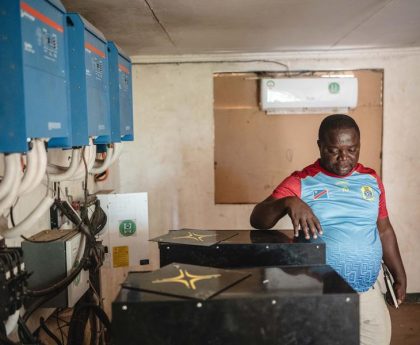By Greg Brophy
For the past 15 years, the Eastern Plains of Colorado have seen a major expansion of wind energy projects, which has injected billions of dollars into local economies.
Over the coming years, however, another renewable energy source – solar power – is also going to become more visible in Eastern Colorado.
To be clear, these new solar facilities are going to have a much lower profile than the wind farms that span tens of thousands of acres in places like Logan, Lincoln, Kit Carson, Cheyenne and Elbert counties. But even if the footprint of these solar projects is smaller, they still represent an
important new economic driver for rural communities – and the next phase of Eastern Colorado’s “all-of-the-above” approach to energy.
A good example of the kind of solar development to expect in Eastern Colorado can be found in Morgan County. Within sight of Interstate 76 in Brush, a community solar facility has been operating since 2020.
The solar facility was a joint project between Pivot Energy, an independent renewable energy developer, and the state’s largest utility company, Xcel Energy.
The project allows homes, businesses and even local governments to become members – or subscribers – of the solar project. They receive a share of the electricity produced by the facility, which is then credited towards their power bills.
The project allows consumers who can’t or don’t want to install solar panels directly on their properties the chance to directly purchase renewable electricity if they wish. It’s a great option for renters – including many businesses that lease rather than own their premises.
Due to the falling cost of electricity from solar panels, subscribing to community solar can also save consumers money compared to simply buying power from the broader grid.
This was one of the reasons why the initial subscribers to the Brush community solar project included the City of Brush, the Brush School District, Weldon Valley School District, Eben Ezer Lutheran Care Center and the East Morgan County Library District, along with a number of local residents.
Pivot Energy and other community solar garden developers are eyeing new projects for Morgan County and other Eastern Plains communities. Besides the energy they produce and economic boost they provide, there’s another reason to eagerly anticipate these projects – the potential for something called “agrivoltaics.”
The term agrivoltaics refers to combining the generation of solar power, farming and livestock on the same land. In practical terms, agrivoltaics refers to building solar panels high enough above the ground that crops can be grown and animals can graze in the shade underneath.
Just like leasing mineral rights to an oil and gas developer, or hosting wind turbines, farmers and ranchers who can host solar projects can tap into a valuable new source of income.
When solar panels are strategically placed and elevated, they create dappled shade, fostering unique microclimates within the agricultural space. This opens doors to cultivating a wider variety of crops or raising different livestock, maximizing the land’s potential. The shade cast by the panels also helps reduce water needed for irrigation.
Interestingly, pilot projects have shown the vegetation growing beneath the panels provides a cooling effect, which in turn enhances the efficiency of the solar panels themselves, allowing them to generate more electricity.
Only time will tell if the new solar projects being considered for Morgan County and other parts of the Eastern Plains will adopt agrivoltaic practices like these. Agrivoltaics is very early in development, there is still significant research to be done, and not every landowner needs or wants to co-locate solar panels with their crops or livestock.
But just as communities of the Eastern Plains have expanded oil, gas and wind energy development while preserving their agricultural character, it’s clear they’ll be able to do the same with solar.
After all, finding innovative ways to generate more income from the same land is the bedrock of farming and ranching communities. Solar projects will be just one more option for landowners to consider as they strive to make their operations more profitable.
This post was originally published on 3rd party site mentioned in the title of this site






